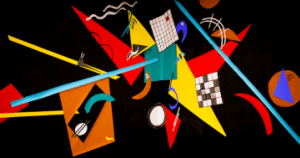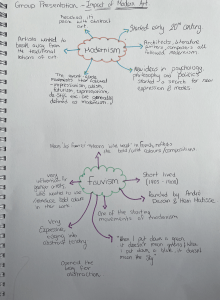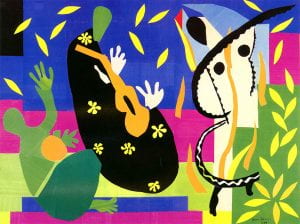For our group presentation we decided to go with the impact of modern art because we were all interested in the separate movements involved in the evolution of art through the twentieth century. We had to research modernism and what it was before we started.
Modernism
Modernism refers to a global movement in society and culture that began in the early decades of the 20th century. Artists believed they could deigns a better life for themselves. They wanted to break away from tradition. The term moved across all forms of creative outlets, such as literate, architecture, art and design , fashion and many more. By the 1960’s modernism had become a dominant term in art, there were many artists that contributed to the key moments in modernism and as a group we want to discuss the most pivotal ones.
We all chose two movements to research and talk about. I chose Fauvism and De Stijl. I wanted to do De Stijl in particular because I found the lecture we had on the Bauhaus was very interesting and it was such a pivotal movement in the world of design I had to include it.
I used my sketchbook to make spider diagrams to start my research and try to focus and zoom in on important facts that I wanted to include.
Fauvism
I started researching Fauvism and this is what I found.
Fauvism was one of the first leading modernism movements in the early 20th century, it was short lived and only lasted about 5 years in total, in comparison to other movements that followed. It refers to ‘Le Fauves’ which is French for the wild beasts. This name was given to the artists for their depictions of their models and use of vibrant colours and shapes.
This is Henri Matisse’s work, he is one of the most well known fauvism artist who founded this movement. Henri was a French artist, painter, printmaker, sculptor and many more. He is most known for his paintings however, and alongside Picasso was one of the artists who helped to define the revolutionary developments in the visual arts throughout the first few decades of the twentieth century.
One of his most famous pieces was the ‘Women with a hat’, his intense use of colourism was eye-catching and very knew to the people of the time, people believed this piece to be unfinished and the ‘loose brushstrokes’ shocked viewers as this wasn’t seen before. It is said that this painted strikes up such controversy and was the catalyst for the start of the ‘Fauvism’ movement along with the other major contributor to this time ‘André Derain’. They both shared an interest for bright colours and expressive brushstrokes on the canvas and were so expressive that they took the paint tubes and applied it straight to the canvas. I found the bright colours and abstract feel so mesmerising and I knew I had to chose this one to talk about. This movement expressed emotion with wild, often dissonant colours, without any regard for the subjects natural colours.
Other artists participated in this movement such as Gustav Moreau who was the movements inspirational teacher, he taught the students to ‘think outside the lines of formality and follow their visions’.
Fauvism in Graphic design
I then began to research fauvism in todays society and I found images such as these
I found that these 21st century artists are taking aspects of fauvism and recreating it/adding it to their own work. I then found lots of images of that broken up leaf image that was from Henri Matisse’s later works and cut outs. This was due to his illness he could no longer stand and paint, therefore he had to come up with new techniques, some of his most creative and interesting work is to have come from this period of his career – the cut outs.
Henri Matisse and Paul Rand.
Through researching more about fauvism in todays society and the art world I discovered that people were linking this bold and vibrant work to Paul Rand – the greater of the IBM logo. Other than his revelations with graphic design and branding Rand also created many posters. His work, like Matisse, was simple in effect yet extremely bold and outgoing. He took inspiration form Matisse’s cut out and collage type pieces as seen here.
Paul’s work:
Matisse’s work:
Masterfully balanced composition, simplicity of forms, the use of austere, pure colours and the technique of cut-out and collage makes the artworks of both artists visually coherent. Seeing that Matisse had this much of an impact of artists work today is exactly why I have to include him in my fauvism research and project, because the reasoning behind this presentation is the impact of modern art, and what better way to display that than showing how fauvism influenced graphic design so heavily.
De Stijl
I then had to chose another movement that interests me and that is, De stills’ impact on the art world. During a lecture, De Stijl and the Bauhaus were mentioned and this amazed me, I thought the narrative of how it came about and had to end was tragically fascinating. I knew I had to include it in the presentation as it was such a defining moment in art and design.
De Stijl was founded by Piet Mondrian and Theo Vandoesburg in 1917, it was a dutch movement that was a response to the horrors of world war 1. These Dutch artists wanted to break away from traditional art and create something new, that hadn’t been seen before. They promoted a style of art that only used horizontal and vertical lines, primary colours and regular forms.
The artists envisioned nothing more but the fusion between function and and form. This resulted in the artwork, architecture etc to become ultimately simplistic but very effective. De Stijl influenced the Bauhaus and the international style, it was used in design, graphic design, typeface, artwork, architecture and many more. This ripple effect took over and De Stijl stands out because its aspirations were as social as they were aesthetic. By ostensibly removing the individualism of the artist in favour of precision and universal harmonies, the De Stijl group believed they were laying the groundwork for a future utopia.
A 1921 painting by Piet Mondrian.
Their goal was to reform society and to do so in their art they took away false distinction of ‘high art’ or ‘applied art’. I found the political aspect of this movement very interesting and I found myself wanting to know more.
Typeface created by Theo VanDoesburg
De Stijl poster
De Stijl today
Through research it wasn’t hard to see that many designers still thrive of this movement and these techniques, many designers believe that De Stijl is the answer to modern designer’s questions. The geometric shapes and simplistic elements make for timeless graphics and is used today by many, I found the very interesting.
‘Inception’ poster-inspired by De still
Gerrit Reitvelds – ‘Red and blue chair’
A De Stijl inspired building in the Netherlands
From seeing all of these images and how De Stijl made such a lasting impression in the art world I knew that it had to be mentioned in our presentation. I learned that the term today that De Stijl has inspired is called ‘colour-blocking’, which is s technique used widely in todays society, particularly in architecture, however it has been adapted, there are more colours and tones being use – its not just primary colours.
I found it very relevant to focus on the use of De Stijl techniques today and how these artists and this moment have is kept alive today because of the impact it has on 21st century artists. To conclude both of these movements and the rest of my group looked at were pivotal moments in the art and design world, influencing type, fashion, movies and many more. Without modernism I feel that todays society would not be so vibrant and exciting.



















